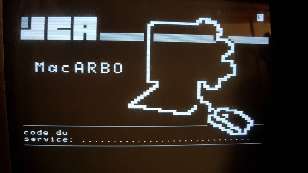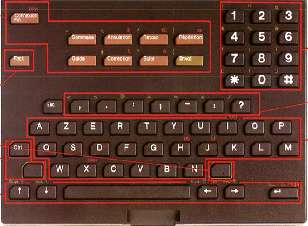Rick's b.log - 2018/08/26
You are 3.144.253.195, pleased to meet you!
Rick's b.log - 2018/08/26 |
|
| It is the 21st of November 2024 You are 3.144.253.195, pleased to meet you! |
|
mailto: blog -at- heyrick -dot- eu
Astonishingly, it worked!
I think it is using standard MODE7 style block graphics for the picture, but the way it does it makes it look better than stuff I've seen on teletext (or viewdata). I recall that Minitel must work in text or graphics mode, as it tends to draw the graphics and then go back and do the text afterwards. Here is another service I called:
Now to reply to some comments by David Pilling:
"Is there a Minitel legacy, some place on the web where one can connect to a Minitel source,". I have found Jelora (who built his own system from the ground up) and JCA (that I think is running it on a Mac of some kind?). I don't imagine there are going to be many services. These days, a monochrome system running at 1200/75 is going to be more a labour of love than anything else, much like those who keep steam engines running.
"can't believe they chucked the lot". I can, sadly. It might have been seen as more expensive to purge the equipment of user data, or maybe all storage was removed and destroyed (leading to what's basically a bunch of possibly OS-less machines and ancient modems). Scans of some of the technical documentation has made it into the wild - search for "stum1b" (~55MB PDF) if you're interested.
"Anyway if there is, you'll be able to test your terminal, and... compare it with the Hearsay emulation." I managed to test the terminal, and it seemed "okay", though one of the problems that I am sure I'm going to run into is the extremely eccentric keyboard layout. Here's a picture of it from the technical guide (the red markings are pointing out the different parts of the keyboard):
"some of the subtleties of French pages were going to escape us. Oddly way back then, no one had test suites, "see if your terminal will pass these tests"."
"I suppose VT100 begat ANSI, which was a standard." Yes, ANSI is basically VT102 with colour. But, no, it's only partially a standard - some of the things like low intensity, blinking, underline, and invisible are implemented in different ways; and alternative character sets and double height/width may not be supported at all. For example, Hearsay supports rapid blick (ESC[6m), and codes in the range 22-27 to turn effects off individually. Is this "standard", as it seems to vary, as does the colour capabilities (eight dim/bright or 216 colours, or 16 level greyscale...). There are also codes for strike-through and Fraktur (!) font support, for maybe the one terminal that actually supports such a thing.
"As ISTR we had dealings about this, for Hearsay I tacked colour codes onto VT <whatever>." Looking at the CSI documentation (that's Control Sequence Introducer, not Crime Scene Investigation!), it looks like ANSI is basically exactly that. VT-blah with colour and stuff bolted on.
"Why they not do Minitel over telnet like Arcade." The service closed in 2012. I guess by then there were better more attractive services. The browser wars were over, HTML was fairly advanced, and the French government had realised that encryption is necessary for e-commerce. Seriously - every time I took my RISC OS machine with SSL and PGP to France with me, I may have technically been breaking the law. It wasn't until 1999 that France looked to permit personal use of encryption technologies, something they are now complaining about due to the terrorist events of recent years (despite no evidence of such technologies being a contributing factor). Anyway, France was "modern" by 2012 and even had broadband rolled out to nowhere places like, well, here. So the switch off of Minitel meant a transition to new technologies.
All this being said, I'm not planning to use the Minitel as a Minitel. I'm likely to use it as a VT100 terminal for debugging.
Minitel online!
Today I decided to bite the bullet, plug my Minitel into the VoIP line, and call Jelora - a homebrew Minitel server written in Java and running on a Pi3! (Jelora is in French)


Plus the thing that looks like it should be an Enter key? In Minitel, at least, one presses Envoi instead of that.
As I said before, I cannot test Hearsay because I don't have a functioning modem... nor a fully wired serial port.
There's the thing. The character sets. American mode offers different characters to French mode, and it looks like it is possible to switch in different characters. Does Hearsay support that? How about status reporting? In the technical manual, part 2 chapter 2 describes some of this behaviour.
Test suites? I think a lot of these things grew organically. I recall discussing with you Hearsay's ANSI terminal behaviour regarding whether to perform a newline upon reaching the end of a line, or when passing beyond the end of the line. I think the latter is more logical. Hearsay, IIRC, does the former. As do DEC terminals if the DEC VT100 guide is anything to go by. But not others. Test suite? ☺
And what's Windows' HyperTerm's "ANSIW" supposed to be?
The reason Arcade is widely supported is because, unlike Minitel, the protocol that Arcade uses is basically the same as that used for remote administration of servers, and command line access via the dumb terminal. It's an old protocol, but extremely widely supported.
David Pilling, 29th August 2018, 22:10
David Pilling, 29th August 2018, 22:19
https://www.davidpilling.com/hearsay.zip
rather than the source code one.
For Viewdata there were numerous pieces of editing software, so a lot of viewdata pages must still exist on anything from BBC to PC discs. I'd expect the same to be true of Minitel.
David Pilling, 29th August 2018, 22:24 Rick, 29th August 2018, 23:45
US character support - that's American mode vs French mode, described using complex things like C0 and C1 characters (or something like that). I'm not entirely sure if Minitel can run in American mode, or if it's only the VT100 that does it.
And, since you're the comms expert around here, what's this X25 PAD stuff? Something about it in the tech guide...Rick, 29th August 2018, 23:50 Rick, 29th August 2018, 23:53 David Pilling, 30th August 2018, 03:11
My Minitel implementation is 100% right, I had no complaints ;-)
With Hearsay having a VT emulator as well as Viewdata (etc). I now dimly recall commands for switching between the two. They definitely exist for things like Tektronix emulation, but yes, for viewdata too.David Pilling, 30th August 2018, 13:23 Rick, 30th August 2018, 14:28
How about JANET?David Pilling, 30th August 2018, 22:27 David Pilling, 13th September 2018, 01:54 David Pilling, 13th September 2018, 13:44 Christian Berger, 14th September 2018, 22:54
My experiments are here https://github.com/Casandro/cas_btx/
I'm actually thinking of a more modern protocol which can be translated to Minitel or Bildschirmtext or Prestel, but offer a wider range of Videotex features with support for UTF-8.
There are now various V.23 modems for Asterisk available, BTW.
| © 2018 Rick Murray |
This web page is licenced for your personal, private, non-commercial use only. No automated processing by advertising systems is permitted. RIPA notice: No consent is given for interception of page transmission. |